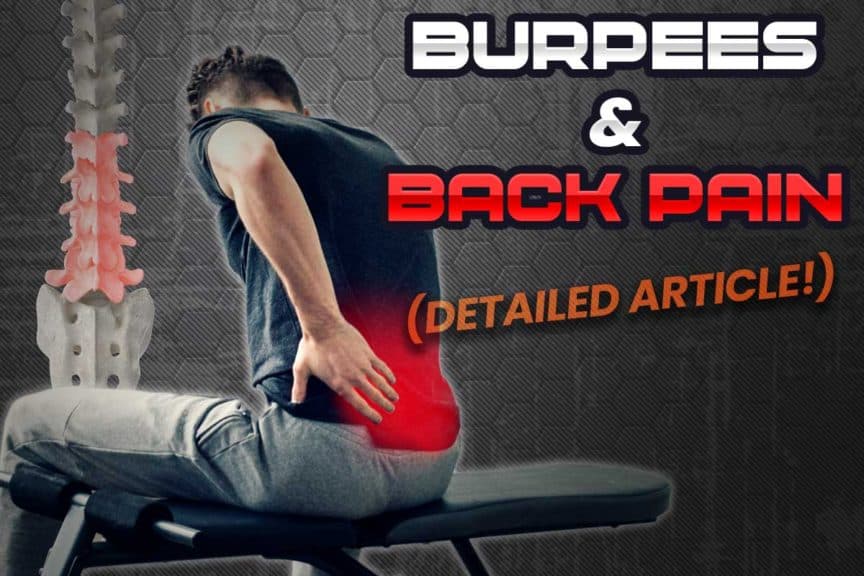The burpee may be a go-to exercise for those looking to burn some calories or push themselves in a workout, but for many, it comes at the expense of a rather sore — or even painful — lower back. If you can relate, this article will walk you through the pertinent details you must be aware of to ensure you’re staying safe and pain-free when performing this exercise. It will even walk you through solutions and alternative exercises to try.
Back pain from burpees is commonly due to poor technique that irritates discs, joints, and nerves in the lower back. Pre-existing back conditions can often make burpees painful, even with great technique. Solutions involve optimizing technique, modifying the exercise or foregoing it altogether.
Whether you need to simply clean up your technique or find ideal alternatives to this exercise, by the end of this article, you’ll have the required information to dial in your technique, modify the exercise, or select appropriate alternatives while being confident that your low back is staying safe and healthy in the process.
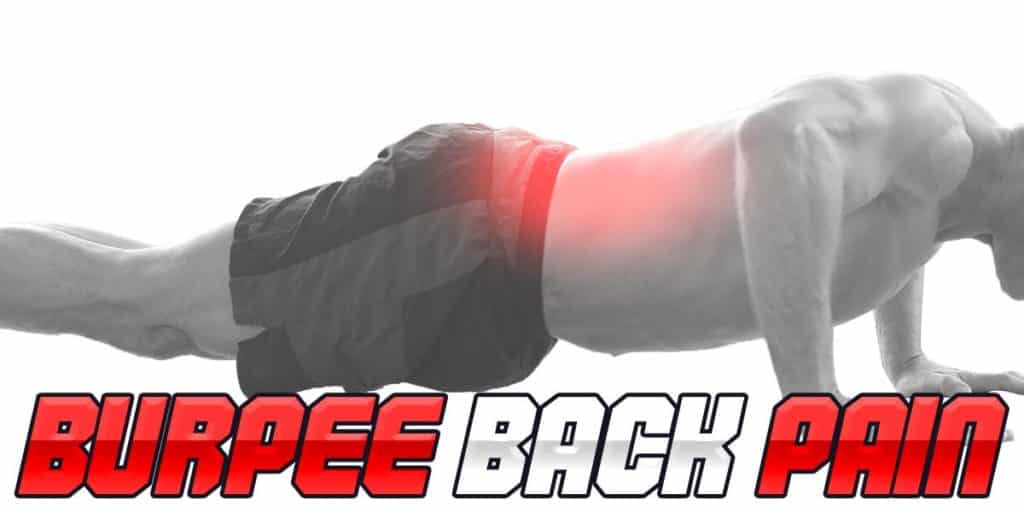
Related article: Why Your Lower Back Hurts After Box Jumps | Errors | Fixes | Pro Tips
Lower back anatomy (must know)
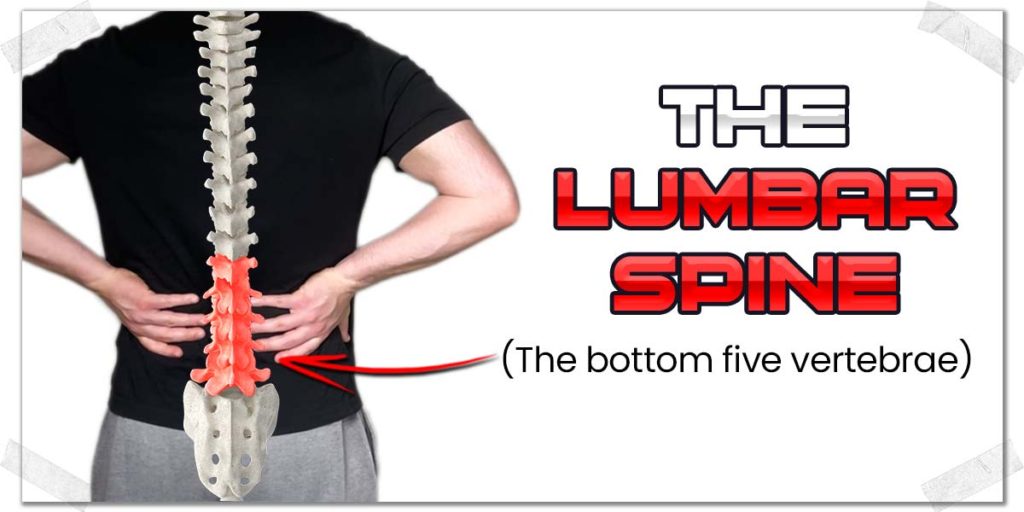
It’s critical to briefly go over the anatomy of your lower back since there are a few key tissues and structures that can act as pain generators. Once you have a basic understanding of these tissues and structures, there’s a good chance that you’ll experience a better overall recovery from your pain, as it will be much more intuitive as to why you’re experiencing pain, why specific interventions can be helpful, and why certain movements or activities should be avoided.
In addition to a quicker and more complete recovery, the result of having a generalized understanding of the anatomy of your lower back will significantly minimize the chances of your back pain returning when performing future burpees or other exercises.
Upwards of 80% of the global population will experience at least one episode of lower back pain within their lifetime.1 One of the many reasons for this high occurrence rate is the numerous types of tissues that can produce pain. For the sake of simplicity within this article, I will focus on the most common sources of pain.
Anatomy FYI: The lower back is anatomically referred to as the lumbar region. The lumbar spine itself refers to the bottom five vertebrae of the spine.
The intervertebral discs
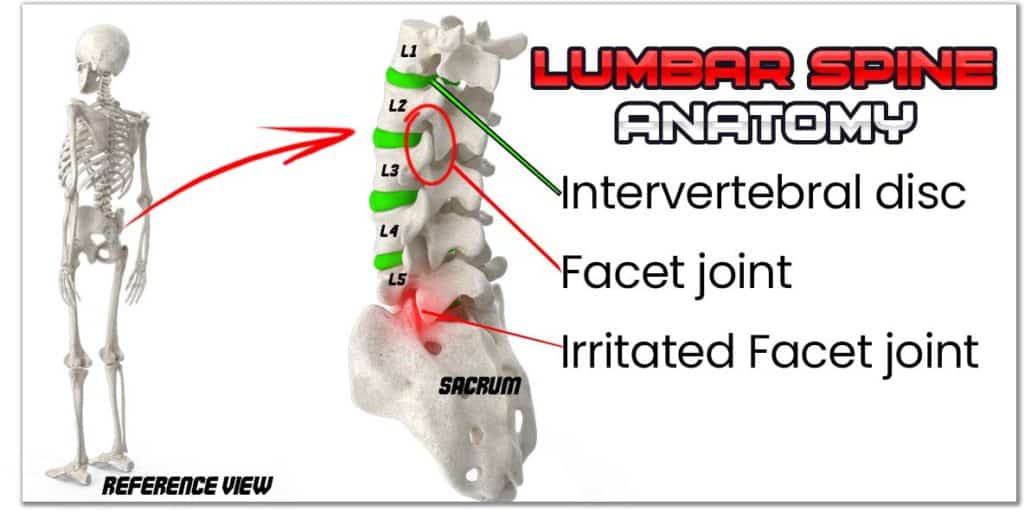
The intervertebral discs of the spine are fibrocartilage structures that help to provide cushioning to the spine as well as provide space between each vertebra, allowing the nerves to extend from the spinal cord and out to the periphery of the body.
The lumbar discs are prone to various disorders and issues that can lead to pain and discomfort. These can be due to factors such as natural aging or poor spinal mechanics, which can irritate or structurally deform the discs. For the sake of this article, I’ll only be focusing on the latter.
When the lumbar spine is subjected to specific types of movements, the discs are subjected to excessive stresses and strain that can cause them to deform in a manner that can create pain. This tends to be through issues involving tearing of the annular fibers of the disc, which can lead to disc bulges, herniations, extrusions or even sequestration of the disc. For simplicity’s sake, don’t worry about the differences between each of these conditions; just know that none of them are ideal.
When discs bulge and deform, it can place pressure on the nerve roots, which are the portions of nerves that directly tie into the spinal cord. When this occurs, it can lead to back pain and even sciatica.
The most commonly affected disc is the disc between the L4-L5 vertebra while the second most common is the L5-S1 disc.2 Discs most often bulge due to forward bending (flexion) of the spine, which forces the inner contents of the disc (the nucleus purposes) to move in a backwards direction, which leads to bulging and herniation.
To learn how to avoid this issue from happening, keep on reading.
The lumbar facet joints
The lumbar facet joints are what links one vertebra to the next, and it’s through these joints that the spine can bend forward (flex) and backward (extend). The facet joints are about the size of your thumbnail and have a natural range of motion they can work through. Like any other joint in the body, forcing them into extreme ranges of flexion or extension can produce irritation, discomfort, or even sharp pain.
Common movement errors such as letting the lumbar spine excessively flex or extend (discussed later within this article) can irritate a sensitive piece of tissue within these joints, known as the meniscoid, which can swell within the joint, leading to sharp pain when moving.
The nerve roots
As briefly mentioned earlier, the nerve roots are the initial segment of nerves that branch off of the spinal cord and run to the periphery of the body, such as into the arms and legs. Nerve roots can become irritated or extra sensitive to pain for various reasons, but in the case of burpees, the cause is most likely to be due to either:
- A mechanical force, such as a disc, pressing onto the nerve root itself
- Heightened mechanosensitivity (being sensitive to stretching or movement) that nerves undergo with physical movements of the torso or limbs.
Keep in mind, however, that back pain is often multifactorial, and in addition to poor mechanics, can also be the result of age-related change, hereditary factors and other pre-existing conditions (all of which are beyond the scope of this article).
Nerve irritation or nerve pain itself tends to be quite distinctive in nature. When it’s nasty, it’s typically perceived as a sudden sharp pain that is felt in a distinct line or path, as if it were an electrical sensation taking place. When more on the mild side, it can often be mistaken for muscle tension or muscle tightness. For the average individual, it can be tricky to differentiate between mild nerve irritation and muscle tension, so if you’re not sure what’s going on, get a qualified healthcare professional to help you out.
The lower back muscles
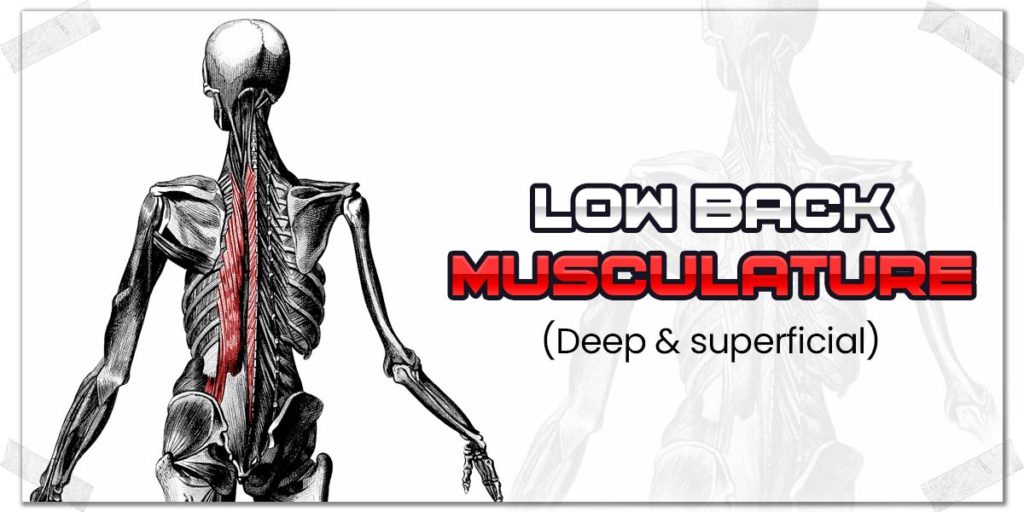
There are numerous muscles of the lower back that work to contribute to stabilizing the spine and producing movement. Muscles can become sore or even painful for numerous reasons.
Most often, soreness of the lower back muscle can be due to:
- Excessive tension or tightness within the muscle
- Inadequate strength of the muscle
- Injuries, such as muscle strains
The muscles of the lower back can be divided into the superficial muscles and the deep muscles.
The deep muscles work to provide stability to the spine and general torso. They include muscles such as the multifidi muscles and the intertransversarri muscles, among a few others.
The superficial muscles tend to be the ones most people are familiar with. They are collectively referred to as the erector spinae muscles and work more to produce movement of the torso than to stabilize the spine.
Related article: Why Your Upper Back Gets Sore From Front Squats (And How to Fix it)
If these muscles must repeatedly work harder than they’re capable of sustaining, or if they’re aggressively stretched out (typically through poor movement mechanics involving lumbar flexion), they can become sore, irritated, and even go into spasm.
Be sure to keep reading to learn how to minimize this from happening.
Hip anatomy (a big issue)
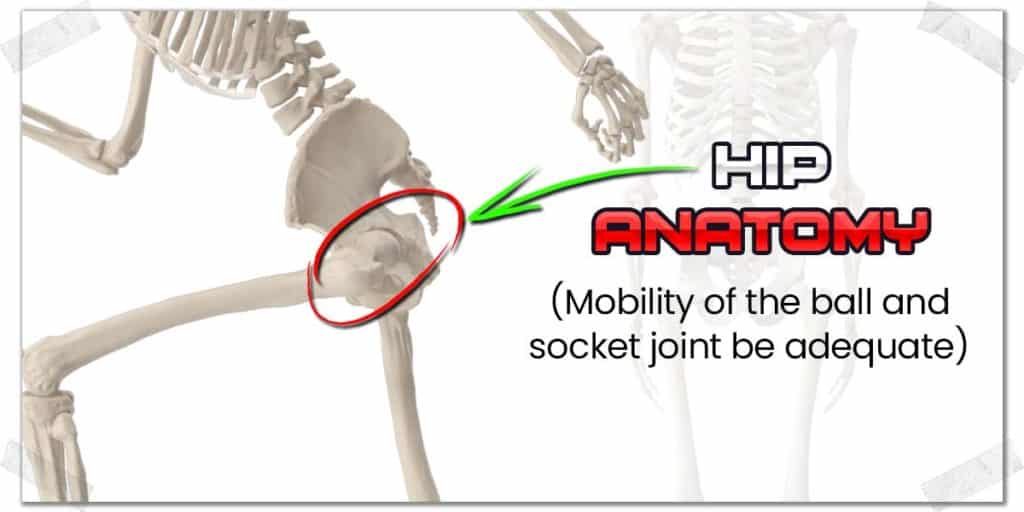
If you’re serious about better understanding the cause(s) of your back pain and fixing the root cause of the issue, a basic understanding of hip anatomy is essential, as hip function is intricately intertwined with lower back function and health.3,4 Hip dysfunction has a very strong correlation to causing lower back pain. And if you keep reading, you’ll see why.
The hip joint
While a number of structures and tissues comprise the hip, the hip joint is the sole focus of this article section. The joint of the hip is known as a ball and socket joint that affords movement in any direction through the spinning of the ball within the socket. When the ball spins in a direction that brings the thighs up towards the chest, it’s referred to as hip flexion.
Limited hip flexion and back pain
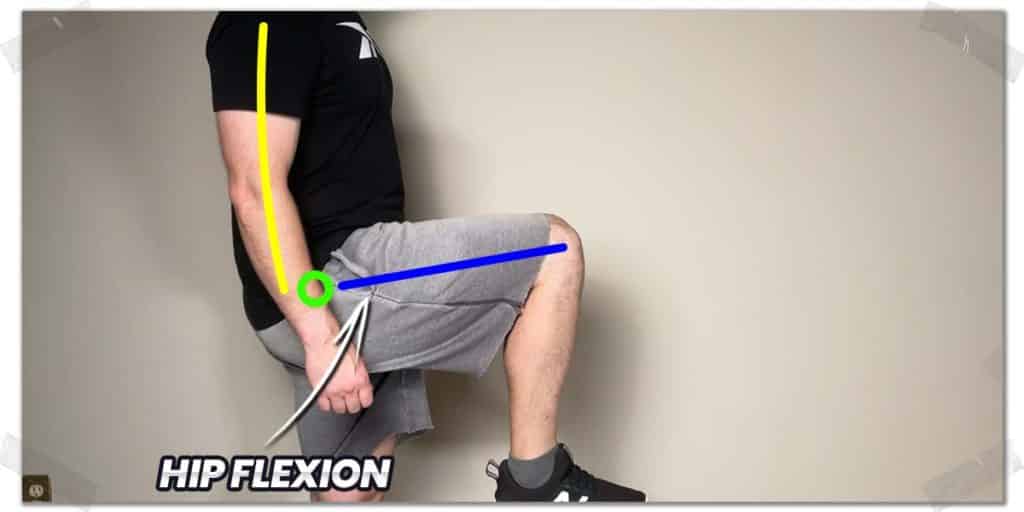
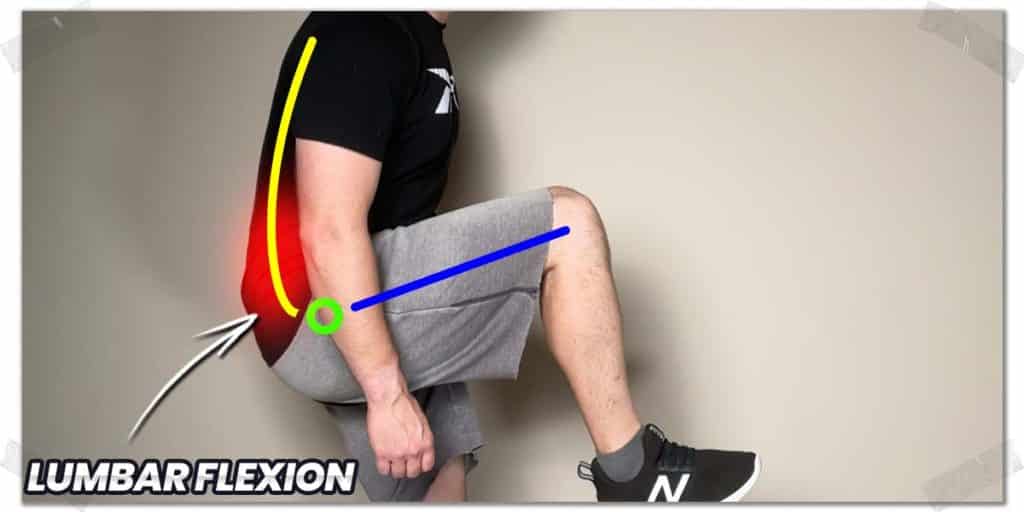
There can be numerous reasons for the hip joint being limited in its ability to produce flexion.
Common reasons include:
- Osteoarthritis of the joint
- Femoral acetabular impingement (FAI)
- Capsular restriction (the thick tissue that wraps and covers the joint)
- Soft tissue (muscle, tendon, fascia) restriction of muscles crossing the joint
Whatever the underlying cause, when flexion is limited within the hip joint, the only way for the body to make up for this reduced mobility is to flex through the lumbar spine (the joints of the lower spine).
Excessive or repeated lumbar spinal flexion can lead to irritation or pain experienced by the facet joints, the intervertebral discs, or the nerve roots of the lower back, all of which can lead to back pain.
There are two primary phases of the burpee that can predispose the lower back to excessive flexion if hip flexion is inadequate. To learn when these phases occur, keep on reading.
Nonetheless, if your hip flexion is limited or inadequate, you’re going to want to determine the precise reason why. Once you do this, you can work on improving and restoring mobility to the joint, which will likely help to keep your lower back safe and healthy.
Related article: Why You Have Hip Pain from Kettlebell Swings (Causes | Fixes | Tips)
Common technique errors
If you’re serious about your exercise longevity and living an active, pain-free life, you must have attention to detail with your exercise technique. This attention to detail helps ensure that you’re not predisposing your body to major technical flaws nor to the seemingly innocuous, minor movement errors that can add up as time goes on.
What follows below are the common movement errors that I constantly see individuals committing when performing their burpees. Each one can irritate the lower back region in unique ways.
If you’re unsure whether you’re committing any of these errors, it might be a good idea to film yourself doing the exercise. If you do so, you can review the footage and critique your technique. If filming yourself isn’t an option, you can consider having a trusted friend or training partner give you feedback on what they see when you do your burpees.
Technique error 1: A saggy lower back
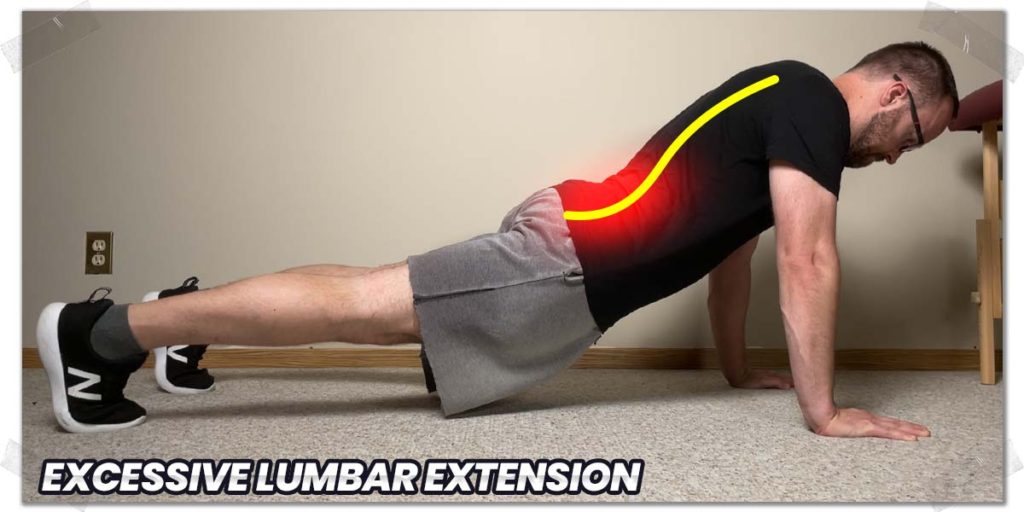
When it comes to the plank portion of the burpee, at no point should the lower back or hips be sagging. This position can be very irritating for the facet joints of the lumbar spine since it forces them to go into an extreme range of extension.
Related article: Why Russian Twists are Hurting Your Lower Back (And What to do About it)
The result can be sharp, pinching pain sensations, or even feelings of restriction or reduced mobility. Facetogenic pain (pain caused by the facet joint) isn’t fun to experience. Thankfully you can significantly minimize your chances of experiencing it by ensuring that your spine is held in a neutral position throughout the floor portion of your burpee.
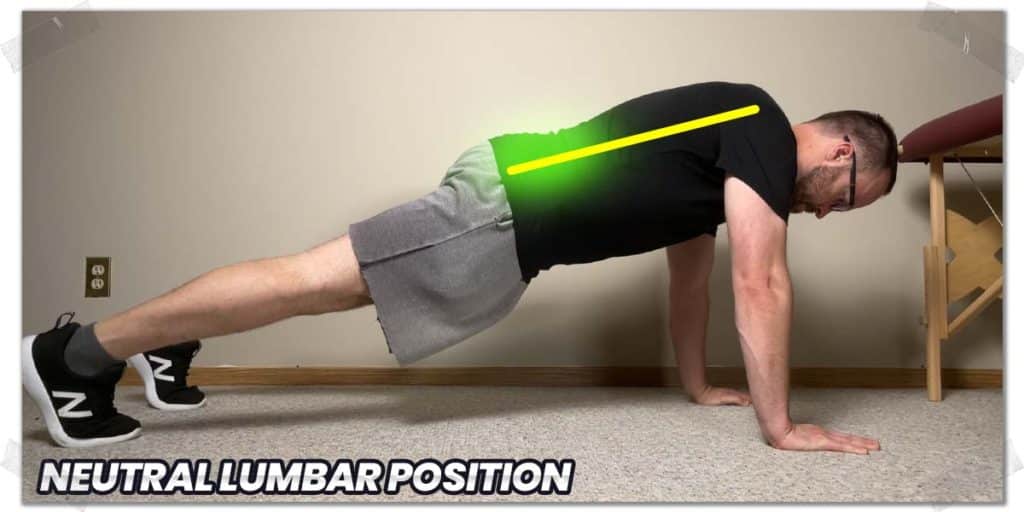
Pro tip: If you’re prone to letting your hips sag, it’s perfectly fine to keep your butt up in the air slightly when in the plank position (as opposed to the traditional plank position); this can help to provide added security that you’re keeping your lower back in a safe position.
Technique error 2: Extreme low back flexion
There are two distinct phases of the burpee where excessive lumbar flexion (rounding of the lower back) is prone to occur. And while some rounding of the lower back usually isn’t problematic, it can indeed quickly become problematic if you have an unhealthy lower back to begin with. It can also become problematic if you use excessive and forceful amounts of lumbar flexion or do so repeatedly over multiple repetitions.
Let’s look at the two distinct points at which it’s common for individuals to excessively round their lower back.
Point 1: When dropping down into the plank position
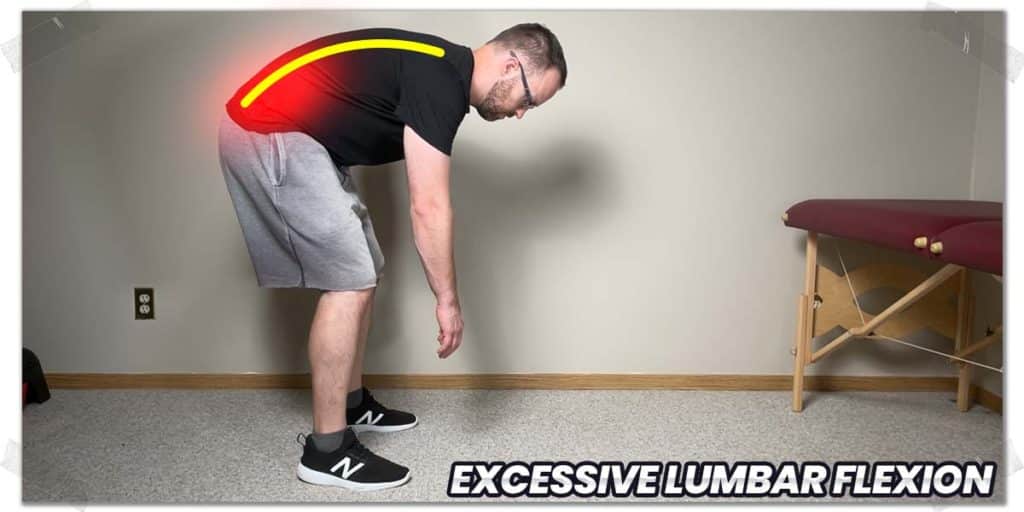
Many individuals neglect their lower back positioning when moving down onto the floor (into the plank position). Instead of attempting to keep the back in more of a neutral position (it won’t be perfectly neutral; however, one should be mindful of the extent of flexion), they forego any conscious awareness of their lower back positioning, resulting in excessive flexion.
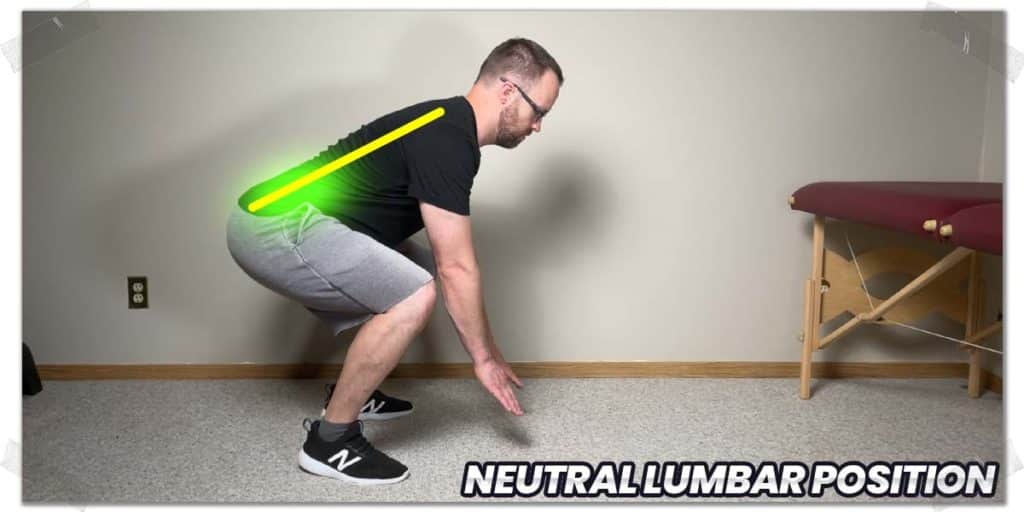
The excessive lumbar flexion when moving onto the planking phase of the burpee should be minimized to avoid irritating the discs, joints, and nerves of the lower back.
Minimizing the extent of lumbar flexion in this phase can be achieved by:
- Descending using ideal squat mechanics that keep the chest and torso in an upright position for as long as possible.
- Hinging at the hips when leaning forward to place the hands on the floor.
- Practicing this portion of the burpee with slow, controlled movement until you can perform it at regular speeds while maintaining minimal lower back flexion.
Additionally, you’ll want to work on improving your hip mobility if it’s found to be limited and, thus, a factor in your excessive lower back rounding.
Point 2: When coming out of the plank position

It can be just as challenging for many individuals to get out of the plank position without excessively rounding their lower back as it is to get into the plank position.
In order to get out of the plank position, the individual will need to quickly bring both knees up towards the chest to help get the feet back directly underneath their body.
The challenge with this movement phase is the extensive amount of hip flexion that must occur to bring the feet directly underneath the body, which not everyone has.
When hip flexion from the ball and socket joint is limited, flexion of the lumbar spine will occur.
Since this phase of the burpee is often ballistic in nature (performed quickly using a high rate of force), it can lead to excessive strain on the low back for specific populations, as the speed of the movement leaves the lower back susceptible to being forced into a range of motion that hyper flexes the facet joints of the lumbar spine.
Solutions for this problem can include:
- Shortening the range of motion you use when bringing your feet underneath you.
- Bringing your feet outside the width of your shoulders, which can help increase the available range of hip flexion motion while minimizing flexion of the lumbar spine.
- Bringing one leg up at a time (i.e., not jumping).
You’ll likely need to play around to see what feels best for you; however, it’s important that you find a solution that minimizes your lumbar flexion. If this can’t be achieved, it may be worth considering ditching the burpee altogether and opting for similar exercises that will challenge you without predisposing your back to lousy positions (keep on reading to learn what these exercises are).
Technique error 3: Hard impacts
There are a few variations in how burpees are performed, so this technique error does not apply to those who aren’t jumping as part of the exercise. However, if you’re putting vertical jumps into the movement, you’ll want to ensure that you’re not landing with excessively hard impacts. This is especially true as you become more fatigued throughout the exercise.
Your goal is to land from each jump with the quietest landing possible. A loud landing signifies you are not absorbing the landing force through your legs, which can produce sudden, jarring forces through your low back.
You want to use your legs as shock absorbers, which help to cushion the landing from your jump. If you’re not dropping into a small or medium squat each time you land, you likely aren’t softening your landing as much as possible. If you’re doing a vertical jump as part of your burpee, practice landing as quietly as possible while controlling the squatting movement you perform as part of the soft landing.
Alternative exercises
If you’re not making any of the above technique errors, or you’re still experiencing lower back pain or discomfort despite having cleaned up your technique, it might be worth ditching the burpee altogether. You can then substitute it with another similar exercise, preferably one that will feel just fine on your back.
What follows below are three great exercises that all offer unique advantages while replicating a specific particular aspect of the burpee. Give them a try if you feel inclined to do so, and swap them out for your burpees if they work for you.
Alternative 1: Thrusters
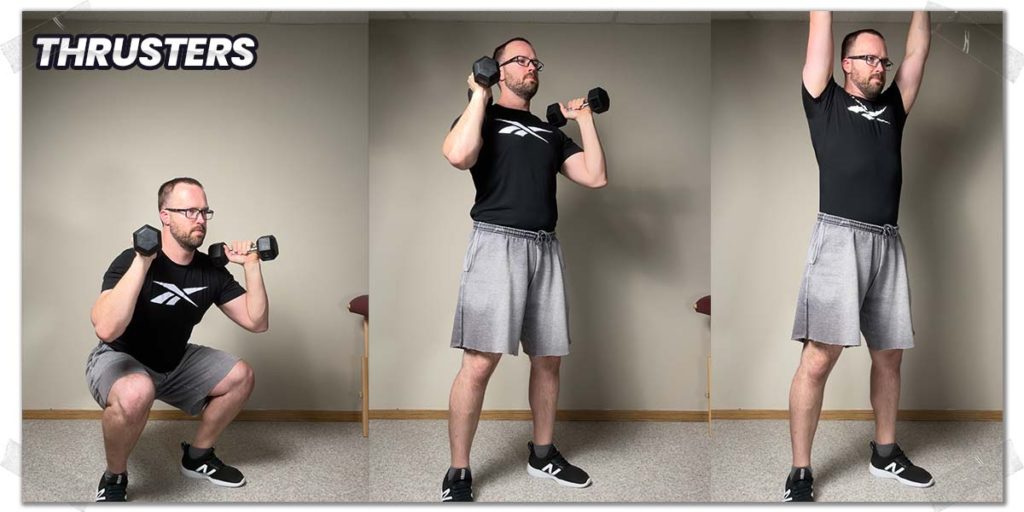
Thrusters are a phenomenal exercise; they work nearly all the major muscle groups in your body and are quite similar to the upright portion of the burpee but will place added emphasis on your shoulders and triceps from pressing weight above your head.
How to perform thrusters
- Hold a dumbbell in each hand around chest level.
- Squat down as low as appropriate for you while keeping the dumbbells at your chest
- As you come up from your squat, press the dumbbells over your head once you’ve returned to the full-standing position.
- As you lower the dumbbells back down to chest-level, begin to sink down into the squat and repeat the process.
The entire movement should be one continuous motion with no discernible stoppage in movement at any point; the moment the squat ends, the press begins, and vice versa.
Alternative 2: Mountain climbers or Spider-Man’s
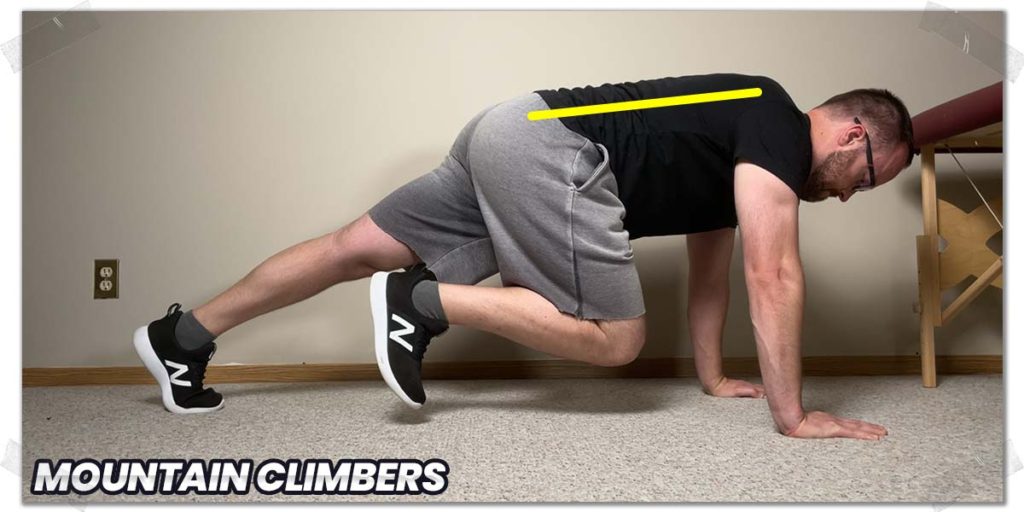
If getting down and up off the floor just isn’t working for your back (or other reasons), but you still want to find an energy-intensive movement similar to the bottom portion of the burpee, mountain climbers or Spider-Man’s will likely do the trick.
Multiple variations can be performed for mountain climbers. The variation I recommend for those who have had lower back pain involves removing the ballistic, jumping portion of the traditional exercise.
The version I will be showing here involves pulling one knee up towards the chest at a time without resting the foot on the ground (i.e., pulling the knee up, then returning to the starting position while the foot is in the air the entire time). This variation dramatically lessens the chances of placing the lumbar spine into extreme flexion, and keeping the foot off the ground helps to eliminate forces through the spine that may lead to irritation.
As with regular burpees, you will need to be mindful of the positioning of your lower back at all times throughout the movement.
How to perform mountain climbers
- Start in the plank position with your hands directly underneath your shoulders.
- Pull one knee up towards your chest while trying to minimize any movement in your upper, middle, and lower back.
- Return to the starting position and repeat the movement with the opposite leg, alternating from one leg to the other.
Pro tip: You can opt to modify this movement by pulling your knee up and outwards so that your knee is outside your arm/shoulder instead of directly underneath your torso. This modification (known as the Spider-Man) can help improve hip flexion range of motion while also minimizing lower back flexion.
Alternative 3: Bench hops

Bench hops can be an ideal exercise to perform if you’re looking for a movement that will get you sweating but without putting excessive amounts of movement through your lower back. You’ll just need to make sure you keep your back in a relatively neutral position throughout the exercise.
And while there’s some light jumping that takes place with this movement, it produces minimal impact on the low back since a good portion of your body weight will be running through your arms rather than your legs.
How to perform bench hops
- Place your hands on an exercise bench and start with your legs off to one side of the bench.
- While leaning forwards onto your hands, hop with both feet over to the other side of the bench.
- Hop back to the same side you started on, repeating for as many repetitions as you desire.
Pro tip: The less time you take between hops, the more intense the exercise will become. Try to minimize the amount of time that your feet are in contact with the ground if you want a good challenge.
Final thoughts
Burpees can be an effective exercise for some individuals, but they’re not ideal for everyone. If you have a history of lower back pain or issues, you will want to be extra mindful of how you feel when you perform this exercise. If you experience lower back pain or are hesitant to perform burpees, there are various other exercises that you can always opt for to keep the physical challenges coming but without putting your lower back in harm’s way.
Now go get your sweat on!
References:
1. Manchikanti L. Epidemiology of low back pain. Pain Physician. 2000;3(2):167-192.

Hi! I’m Jim Wittstrom, PT, DPT, CSCS, Pn1.
I am a physical therapist who is passionate about all things pertaining to strength & conditioning, human movement, injury prevention and rehabilitation. I created StrengthResurgence.com in order to help others become stronger and healthier. I also love helping aspiring students and therapists fulfill their dreams of becoming successful in school and within their clinical PT practice. Thanks for checking out my site!

